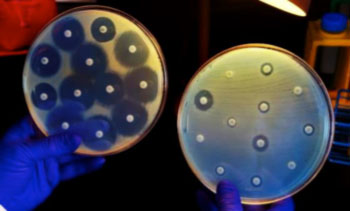Common Bacteria May Become Antibiotic-Resistant Superbugs
|
By LabMedica International staff writers Posted on 07 Apr 2015 |

Image: The plate on the right was inoculated with a Carbapenem-Resistant Enterobacteriaceae (CRE) bacterium that proved to be resistant to all of the antibiotics tested; bacteria in the left plate are susceptible to the antibiotics on the discs (Photo courtesy of James Gathany).
Pathogenic Enterobacteriaceae, including Escherichia coli and Klebsiella pneumoniae, are major causes of multidrug resistant (MDR) infections in hospitals worldwide and these pathogens have recently been shown to have acquired resistance to carbapenems.
Two genes have been identified that confer resistance against a particularly strong class of antibiotics can be shared easily among a family of bacteria responsible for a significant portion of hospital-associated respiratory and urinary infections.
Scientists at Washington University School of Medicine (St. Louis, MO, USA) collected 450 bacterial isolates, including 195 Enterobacteriaceae in Pakistan, during February 2012 to March 2013. They randomly selected 55 Enterobacteriaceae isolates for whole-genome sequencing. They then selected 23 isolates from samples collected in the USA during January 2010 to June 2013 from patients in Barnes Jewish Hospital (St. Louis, MO, USA), that had similar proportions of β-lactam susceptibility and resistance to the isolates collected in Pakistan for sequencing.
The investigators also sequenced a special portion of bacterial genetic material called plasmids. Most of a bacteria's DNA is found in its chromosome, but bacteria also have many extra, smaller and circular bits of DNA known as plasmids that easily can pass from one bacterial strain to another. A plasmid is like a bacterial gene delivery truck; it is the primary way antibiotic resistance genes spread between bacteria.
The variety of strains that they discovered encoding Klebsiella pneumoniae carbapenemase (KPC) and New Delhi metallo-β-Lacatamase-1 (NDM-1) was consistent with existing evidence that horizontal gene transfer (HGT) is a major factor in their spread. They identified a few key instances in which the plasmids carrying NDM-1 or KPC were nearly identical, which means they easily could facilitate the spread of antibiotic resistance between disease-causing bacteria found in the USA and South Asia.
Gautam Dantas, PhD, associate professor of pathology and immunology, a senior author of the study, said, “Our findings also suggest it's going to get easier for strains of these bacteria that are not yet resistant to pick up a gene that lets them survive carbapenem treatment. Carbapenems are one of our last resorts for treating bacterial infections, what we use when nothing else works. As drug-resistant forms of Enterobacteriaceae become more widespread, the odds will increase that we'll pass one of these superbugs on to a friend with a weakened immune system who can really be hurt by them.” The study was published online in March 2015 for the June 2015 issue of the journal Emerging Infectious Diseases.
Related Links:
Washington University School of Medicine
Barnes Jewish Hospital
Two genes have been identified that confer resistance against a particularly strong class of antibiotics can be shared easily among a family of bacteria responsible for a significant portion of hospital-associated respiratory and urinary infections.
Scientists at Washington University School of Medicine (St. Louis, MO, USA) collected 450 bacterial isolates, including 195 Enterobacteriaceae in Pakistan, during February 2012 to March 2013. They randomly selected 55 Enterobacteriaceae isolates for whole-genome sequencing. They then selected 23 isolates from samples collected in the USA during January 2010 to June 2013 from patients in Barnes Jewish Hospital (St. Louis, MO, USA), that had similar proportions of β-lactam susceptibility and resistance to the isolates collected in Pakistan for sequencing.
The investigators also sequenced a special portion of bacterial genetic material called plasmids. Most of a bacteria's DNA is found in its chromosome, but bacteria also have many extra, smaller and circular bits of DNA known as plasmids that easily can pass from one bacterial strain to another. A plasmid is like a bacterial gene delivery truck; it is the primary way antibiotic resistance genes spread between bacteria.
The variety of strains that they discovered encoding Klebsiella pneumoniae carbapenemase (KPC) and New Delhi metallo-β-Lacatamase-1 (NDM-1) was consistent with existing evidence that horizontal gene transfer (HGT) is a major factor in their spread. They identified a few key instances in which the plasmids carrying NDM-1 or KPC were nearly identical, which means they easily could facilitate the spread of antibiotic resistance between disease-causing bacteria found in the USA and South Asia.
Gautam Dantas, PhD, associate professor of pathology and immunology, a senior author of the study, said, “Our findings also suggest it's going to get easier for strains of these bacteria that are not yet resistant to pick up a gene that lets them survive carbapenem treatment. Carbapenems are one of our last resorts for treating bacterial infections, what we use when nothing else works. As drug-resistant forms of Enterobacteriaceae become more widespread, the odds will increase that we'll pass one of these superbugs on to a friend with a weakened immune system who can really be hurt by them.” The study was published online in March 2015 for the June 2015 issue of the journal Emerging Infectious Diseases.
Related Links:
Washington University School of Medicine
Barnes Jewish Hospital
Latest Microbiology News
- High-Accuracy Bedside Test to Diagnose Periprosthetic Joint Infection in Five Minutes
- Innovative Diagnostic Approach for Bacterial Infections to Enable Faster and Effective Treatment
- Non-Invasive Stool Test to Diagnose Endometriosis and Help Reduce Disease Progression
- Automated Positive Blood Culture Sample Preparation Platform Designed to Fight Against Sepsis and AMR
- Revolutionary Molecular Culture ID Technology to Transform Bacterial Diagnostics
- New Digital PCR Assays Enable Accurate and Sensitive Detection of Critical Pathogens
- Rapid Diagnostic System to Deliver Same-Shift Antibiotic Susceptibility Test Results
- AST System Delivers Actionable Results for Gram-Negative Bacteria Directly from Positive Blood Cultures
- Ultra-Rapid Culture-Free Sepsis Test Reduces Testing Time from Days to Hours
- New Rapid Method for Determining Virus Infectivity Could Revolutionize Response to Future Pandemics
- Novel Molecular Test to Help Prevent and Control Multi Drug-Resistant Fungal Pathogen in Healthcare Settings
- Innovative C. Difficile Diagnostic Test Provides Both GDH and Toxin Results within 30 Minutes
- Rapid UTI Test Cuts Detection Time from 3 days to 45 Minutes
- POC STI Test Shortens Time from ED Arrival to Test Results
- Integrated Solution Ushers New Era of Automated Tuberculosis Testing
- Automated Sepsis Test System Enables Rapid Diagnosis for Patients with Severe Bloodstream Infections
Channels
Clinical Chemistry
view channel.jpg)
POC Saliva Testing Device Predicts Heart Failure in 15 Minutes
Heart failure is a serious condition where the heart muscle is unable to pump sufficient oxygen-rich blood throughout the body. It ranks as a major cause of death globally and is particularly fatal for... Read more
Screening Tool Detects Multiple Health Conditions from Single Blood Drop
Infrared spectroscopy, a method using infrared light to study the molecular composition of substances, has been a foundational tool in chemistry for decades, functioning similarly to a molecular fingerprinting... Read more
Integrated Chemistry and Immunoassay Analyzer with Extensive Assay Menu Offers Flexibility, Scalability and Data Commutability
As global healthcare systems increasingly shift towards networked laboratory operational models to enhance efficiency and patient access, there is a greater need for innovative solutions tailored to the... Read moreMolecular Diagnostics
view channel
Respiratory Panel to Help Clinicians Make Precise Treatment Decisions in Outpatient Settings
Respiratory tract infections are the primary reason for visits to emergency departments and subsequent hospitalizations. In the U.S., it is estimated that there are up to 41 million cases of influenza... Read more
Integrating Cardiovascular Risk Biomarkers Aids in Detection of ‘Inflammaging’
Cardiovascular diseases (CVD) continue to be the leading cause of death globally, responsible for nearly one-third of all fatalities worldwide. Traditionally, risk assessment for CVD has focused on well-established... Read more
Genetic Signature in Newborns Predicts Neonatal Sepsis Before Symptoms Appear
Neonatal sepsis, which occurs due to the body’s abnormal response to severe infection within the first 28 days of life, results in approximately 200,000 deaths globally each year. This condition affects around 1.... Read more.jpeg)
Integrating Multiple Protein Markers Predicts Health Outcomes in Chronic Kidney Disease Patients
Previous attempts to discover novel kidney biomarkers as risk factors for chronic kidney disease (CKD) progression have generally focused on evaluating proteins individually, which limits their prognostic... Read moreHematology
view channel
Next Gen CBC and Sepsis Diagnostic System Targets Faster, Earlier, Easier Results
Every hour is critical in protecting patients from infections, yet there are currently limited tools to assist in early diagnosis before patients reach a hospital. The complete blood count (CBC) is a common... Read more
Newly Discovered Blood Group System to Help Identify and Treat Rare Patients
The AnWj blood group antigen, a surface marker discovered in 1972, has remained a mystery regarding its genetic origin—until now. The most common cause of being AnWj-negative is linked to hematological... Read more
Blood Platelet Score Detects Previously Unmeasured Risk of Heart Attack and Stroke
Platelets, which are cell fragments circulating in the blood, play a critical role in clot formation to stop bleeding. However, in some individuals, platelets can become "hyperreactive," leading to excessive... Read moreImmunology
view channel
Computational Tool Predicts Immunotherapy Outcomes for Metastatic Breast Cancer Patients
Immunotherapy aims to enhance the body’s immune response to target cancer cells, but not all patients experience a positive reaction to such treatments. Identifying which patients will benefit from immunotherapy... Read more
Biomarker Could Predict Immunotherapy Response in Liver Cancer
Until recently, patients diagnosed with hepatocellular carcinoma had limited treatment options, with existing therapies extending life by only a few months. Immunotherapy has emerged as a new alternative... Read more
Epigenetic Test Could Determine Efficacy of New Immunotherapy Treatments Against Multiple Myeloma
Multiple myeloma is a blood cancer that primarily affects individuals over the age of sixty, and its occurrence rises as the population ages. In this disease, the bone marrow—the spongy tissue inside bones... Read morePathology
view channel
New Imaging Method Opens Door to Precision Diagnostics for Head and Neck Cancers
Head and neck cancers, while considered rare, represent a significant portion of cancer cases and have seen a notable increase over the past 30 years. These cancers encompass various malignant tumors that... Read more
Faster Measurement of Vibrational Fingerprint of Molecules to Advance Biomedical Diagnostics
Identifying different types of molecules and cells is a vital process in both basic and applied science. Raman spectroscopy serves as a widely utilized measurement technique for this purpose.... Read moreTechnology
view channel
New Noninvasive Methods Detect Lead Exposure Faster, Easier and More Accurately at POC
Exposure to lead can negatively affect health in multiple ways, leading to damage in the brain and central nervous system, delays in development and growth, learning and behavioral issues, problems with... Read more
Noninvasive Test Detects Malaria Without Blood Sample
Malaria remains a significant global health issue, with approximately 250 million cases and over 600,000 deaths reported annually. Nearly half of the world's population is at risk for malaria infection,... Read moreIndustry
view channel
Beckman Coulter Partners with BioPorto for Global Distribution of Acute Kidney Injury NGAL Tests
Acute kidney injury (AKI) is a sudden episode of kidney failure or damage that can occur within a few hours or days. This condition leads to the accumulation of waste products in the blood and disrupts... Read more_1.jpg)
CACLP 2025 New Date and Venue Announced
The 22nd China International In Vitro Diagnostic Expo, organized by the China Association of Clinical Laboratory Practice Expo (CACLP, Shanghai, China), is set to take place from March 21 to 24, 2025,... Read more
Roche to Develop New Diagnostic Technologies for Traumatic Brain Injuries
Traumatic brain injuries (TBI) represent a significant global health issue, affecting approximately 69 million people each year. TBI occurs when an external force disrupts normal brain function, with severity... Read more
















